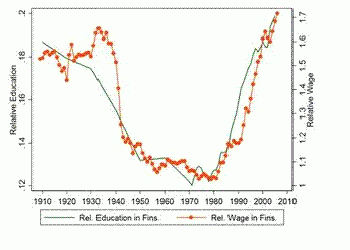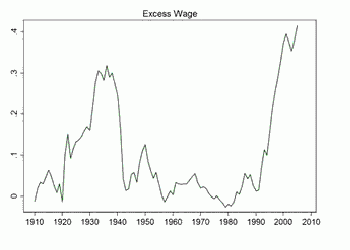Employees of the financial industry have enjoyed very high compensation in recent years. The bonuses of Wall Street reached more than $200,000 per employee in 2007. Bonuses fell in 2008 but remain surprisingly high in light of the industry's dismal performance. So, are bankers over-paid, as some argue (Duflo 2008)?
The history of wages and human capital in the US financial sector turns out to be quite fascinating. Before I spoil the suspense by showing you what actually happened, ask yourself what one should expect. Here are a few hypotheses:
- "Textbook economics" hypothesis: finance has always been a relatively high skill/high pay industry. So financiers have always been more educated and more highly paid than the average worker, and this reflects an efficient allocation of human resources.
- "Bankers as parasite" hypothesis: finance wages are unrelated to their true contributions to economic prosperity.
- "Stock market" hypothesis: when the stock market goes up, wages in finance go up (why this should be the case remains unclear, however)
- "Computer" hypothesis: all these traders and managers have seen their productivity boosted by computers and IT. This is why they earn so much.
These are just a few extreme hypotheses, and they are not mutually exclusive. It turns out, however, that none of them is quite correct.
Historical Evidence
Ariell Resheff and I have analysed human capital and wages in the US financial sector over the past century. The implications for the global crisis can be found here.
Our analysis reveals a set of new facts. First, the relative skill intensity and relative wages of the financial sector exhibit a U-shaped pattern from 1909 to 2006. From 1909 to 1933 the financial sector was a high skill, high wage industry. A dramatic shift occurred during the 1930s: the financial sector rapidly lost its high human capital and its wage premium relative to the rest of the private sector. The decline continued at a more moderate pace from 1950 to 1980. By that time, wages in the financial sector were similar, on average, to wages in the rest of the economy. From 1980 onward, another dramatic shift occurred. The financial sector became once again a high skill/high wage industry. Strikingly, by the end of the sample, relative wages and relative education levels went back almost exactly to their pre-1930s levels.
 |
Using micro data on occupations, we create indices to measure the complexity of the tasks performed by the financial industry. Using this index, we document a similar U-shaped pattern over the past century: financial jobs were relatively more complex and non-routine than non-financial jobs before 1930 and after 1980, but not in the middle of the sample.
We then try to identify the forces responsible for the evolution of human capital in the financial industry.
The fact that relative wages and education in finance were just as high in the 1920s as in the 1990s rules out technology -- in particular information technology -- as the main driving force. There were no computers in private use before 1960. Therefore, the idea that the growth of wages in finance is simply the mechanical consequence of the IT revolution is inconsistent with the historical evidence.
The historical facts also rule out some simple macroeconomic explanations. For instance, the average price/earnings ratio and the ratio of stock market to GDP are not very correlated with the relative wage series. There is a stock market boom in the 1960s, and a collapse after 2001. Overall, the correlation with the relative wage series is small. The same is true of the ratio of trade to GDP.
Our investigation reveals a very tight link between deregulation and human capital in the financial sector. Highly skilled labour left the financial sector in the wake of Depression era regulations, and started flowing back precisely when these regulations were removed. This link holds both for finance as a whole, as well as for subsectors within finance. Along with our relative complexity indices, this suggests that regulation inhibits the ability to exploit the creativity and innovation of educated and skilled workers. Deregulation unleashes creativity and innovation and increases demand for skilled workers.
The second set of forces that appear to have a large influence on the demand for skills in finance are non-financial corporate activities: in particular, IPOs and credit risk. New firms are difficult to value because they are often associated with new technologies or new business models, and also for the obvious reason that they do not have a track record. Similarly, pricing and hedging risky debt is an order of magnitude harder than pricing and hedging government debt. Indeed, we find that increases in aggregate IPO activities and credit risk predict increases in human capital intensity in the financial industry. Computers and information technology also play a role, albeit a more limited one. Contrary to common wisdom, computers cannot account for the evolution of the financial industry. The financial industry of the 1920s appears remarkably similar to the financial industry of the 1990s despite the lack of computers in the early part of the sample.
Are bankers over-paid?
Has financial creativity been over compensated? We construct a benchmark series for the relative wage in finance, controlling for education and employment risk as well as time varying returns to education. Our benchmark wage accounts well for the observed relative wage between 1910 and 1920, and from 1950 to 1990. From the mid-1920s to the mid-1930s, and from the mid-1990s to 2006, however, the compensation of employees in the financial industry appears to be too high to be consistent with a sustainable labour-market equilibrium.
Overall, we conclude that bankers were paid about 40% too much in 2006.
Conclusion
In the long run, it appears that the most important factors driving the relative skill demand and relative wages in the financial sector are regulation and corporate finance activity, followed by financial innovation.
Moreover, we show that the nature and timing of regulatory changes point toward a causal role for deregulation and creative destruction in the corporate sector, triggered by technological revolutions.
On the one hand, the change in the relative wage of finance employees is part of an efficient market response to a change in the economic environment. We show in particular that corporate finance needs from the non financial sector help explain the demand for skills in the financial industry.
On the other hand, we find that rents account for 30% to 50% of the wage differentials observed since the late 1990s. In that sense, financiers are overpaid.
Our results have another important implication for regulation. Following the crisis of 1930-1933 and 2007-2008, regulators have been blamed for lax oversight. The Pecora Hearings of 1933 and 1934 documented such lax oversight and made the case for financial regulation; this led to the Glass-Steagall Act, the Securities Act of 1933 and the Securities Exchange Act of 1934.
In retrospect, it is clear that regulators did not have the human capital to keep up with the financial industry, and to understand it well enough to be able to exert effective regulation.
Given the wage premia that we document, it was impossible for regulators to attract and retain highly-skilled financial workers, because they could not compete with private sector wages. Our approach therefore provides an explanation for regulatory failures.
Of course, regulators will be able to hire cheap skilled labour in 2009, just as they were able to in the 1930s.
Editors’ note: A version of this first appeared on the blog Stern on Finance.






